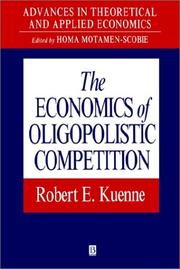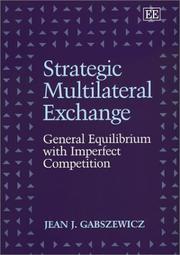| Listing 1 - 10 of 146 | << page >> |
Sort by
|

ISBN: 0521282446 0521238277 0511571895 9780521282444 9780521238274 9780511571893 Year: 1983 Publisher: Cambridge Cambridge University Press
Abstract | Keywords | Export | Availability | Bookmark
 Loading...
Loading...Choose an application
- Reference Manager
- EndNote
- RefWorks (Direct export to RefWorks)
James Friedman provides a thorough survey of oligopoly theory using numerical examples and careful verbal explanations to make the ideas clear and accessible. While the earlier ideas of Cournot, Hotelling, and Chamberlin are presented, the larger part of the book is devoted to the modern work on oligopoly that has resulted from the application of dynamic techniques and game theory to this area of economics. The book begins with static oligopoly theory. Cournot's model and its more recent elaborations are covered in the first substantive chapter. Then the Chamberlinian analysis of product differentiation, spatial competition, and characteristics space is set out. The subsequent chapters on modern work deal with reaction functions, advertising, oligopoly with capital, entry, and oligopoly using noncooperative game theory. A large bibliography is provided.
Oligopolies --- Oligopoles --- Microeconomics --- 380.22 --- AA / International- internationaal --- Economic concentration --- Monopolies, Partial --- Partial monopolies --- Competition, Imperfect --- Interorganizational relations --- Concurrentie. Monopolie, duopolie, oligopolie --- Business, Economy and Management --- Economics --- Oligopolies.
Book
ISBN: 981461968X Year: 2015 Publisher: New Jersey : World Scientific,
Abstract | Keywords | Export | Availability | Bookmark
 Loading...
Loading...Choose an application
- Reference Manager
- EndNote
- RefWorks (Direct export to RefWorks)
Few financial mathematical books have discussed mathematically acceptable boundary conditions for the degenerate diffusion equations in finance. In The Time-Discrete Method of Lines for Options and Bonds, Gunter H. Meyer examines PDE models for financial derivatives and shows where the Fichera theory requires the pricing equation at degenerate boundary points, and what modifications of it lead to acceptable tangential boundary conditions at non-degenerate points on computational boundaries when no financial data are available. Extensive numerical simulations are carried out with the method of lines to examine the influence of the finite computational domain and of the chosen boundary conditions on option and bond prices in one and two dimensions, reflecting multiple assets, stochastic volatility, jump diffusion and uncertain parameters. Special emphasis is given to early exercise boundaries, prices and their derivatives near expiration. Detailed graphs and tables are included which may serve as benchmark data for solutions found with competing numerical methods.
Derivative securities --- Options (Finance) --- Bonds --- Discrete-time systems. --- Differential equations, Partial. --- Mathematical models.
Book
ISBN: 1438454872 9781438454870 9781438454856 1438454856 1438454864 9781438454863 Year: 2015 Publisher: Albany
Abstract | Keywords | Export | Availability | Bookmark
 Loading...
Loading...Choose an application
- Reference Manager
- EndNote
- RefWorks (Direct export to RefWorks)
The largest, wealthiest corporations have gained unprecedented power and influence in contemporary life. From cradle to grave the decisions made by these entities have an enormous impact on how we live and work, what we eat, our physical and psychological health, what we know or believe, whom we elect, and how we deal with one another and with the natural world around us. At the same time, government seems ever more subservient to the power of these oligopolies, providing numerous forms of corporate welfare—tax breaks, subsidies, guarantees, and bailouts—while neglecting the most basic needs of the population. In Corporate Power, Oligopolies, and the Crisis of the State, Luis Suarez-Villa employs a multidisciplinary perspective to provide unprecedented documentation of a growing crisis of governance, marked by a massive transfer of risk from the private sector to the state, skyrocketing debt, great inequality and economic insecurity, along with an alignment of the interests of politicians and a new, minuscule but immensely wealthy and influential corporate elite. Thanks to this dysfunctional environment, Suarez-Villa argues, stagnation and a vanishing public trust have become the hallmarks of our time.
Corporate governance. --- Oligopolies. --- State, The. --- Administration --- Commonwealth, The --- Sovereignty --- Political science --- Economic concentration --- Monopolies, Partial --- Partial monopolies --- Competition, Imperfect --- Interorganizational relations --- Governance, Corporate --- Industrial management --- Directors of corporations --- Corporate governance --- Oligopolies --- State, The --- E-books
Book
ISBN: 1282883542 9786612883545 0470683740 0470669349 0470669330 9780470669334 9780470669341 9780470683750 0470683759 9780470683743 9781282883543 6612883545 Year: 2010 Publisher: Chichester ; Malden, MA : Wiley-Blackwell,
Abstract | Keywords | Export | Availability | Bookmark
 Loading...
Loading...Choose an application
- Reference Manager
- EndNote
- RefWorks (Direct export to RefWorks)
The second edition of Dyslexia in the Workplace is a comprehensive guide to how dyslexic adults in employment can improve their skills, and how their employers and other professionals can help.Offers invaluable insights for overcoming obstacles to success, enhancing workplace efficiency and ensuring that dyslexic employees achieve their full potentialWritten in an accessible style that is perfect for professionals and dyslexic individuals alikeCovers related syndromes such as dyspraxia, attention deficit disorder and visual stressExplores the legal obligations and ot
Dyslexics --- People with disabilities --- Dyslexia. --- Developmental dyslexia --- Word-blindness, Partial --- Language disorders --- Reading disability --- Alexia --- Supported employment --- Dyslexia --- Dyslexiacs --- Dyslexic persons --- Developmentally disabled --- Employment. --- Patients --- Employment --- E-books
Book
Year: 2011 Publisher: Washington, D.C., The World Bank,
Abstract | Keywords | Export | Availability | Bookmark
 Loading...
Loading...Choose an application
- Reference Manager
- EndNote
- RefWorks (Direct export to RefWorks)
The global financial crisis brought public guarantees to the forefront of the policy debate. Based on a review of the theoretical foundations of public guarantees, this paper concludes that the commonly used justifications for public guarantees based solely on agency frictions (such as adverse selection or lack of collateral) and/or un-internalized externalities are flawed. When risk is idiosyncratic, it is highly unlikely that a case for guarantees can be made without risk aversion. When risk aversion is explicitly added to the picture, public guarantees may be justified by the state's natural advantage in dealing with collective action failures (providing public goods). The state can spread risk more finely across space and time because it can coordinate and pool atomistic agents that would otherwise not organize themselves to solve monitoring or commitment problems. Public guarantees may be transitory, until financial systems mature, or permanent, when risk is fat-tailed. In the case of aggregate (non-diversifiable) risk, permanent public guarantees may also be justified, but in this case the state adds value not by spreading risk but by coordinating agents. In addition to greater transparency in justifying public guarantees, the analysis calls for exploiting the natural complementarities between the state and the markets in bearing risk.
Access to Finance --- Arrow-Lind theorem --- Banks & Banking Reform --- Debt Markets --- Finance and Financial Sector Development --- Financial intermediaries --- Insurance & Risk Mitigation --- Labor Policies --- Lender of last resort --- Partial credit guarantees --- Public guarantees --- Public risk absorption --- Risk premia
Book
Year: 2012 Publisher: Washington, D.C., The World Bank,
Abstract | Keywords | Export | Availability | Bookmark
 Loading...
Loading...Choose an application
- Reference Manager
- EndNote
- RefWorks (Direct export to RefWorks)
Labor markets are increasingly global. Overseas work can enrich households but also split them geographically, with ambiguous net effects on decisions about work, investment, and education. These net effects, and their mechanisms, are poorly understood. This study investigates a policy discontinuity in the Philippines that resulted in quasi-random assignment of temporary, partial-household migration to high-wage jobs in Korea. This allows unusually reliable measurement of the reduced-form effect of these overseas jobs on migrant households. A purpose-built survey allows nonexperimental tests of different theoretical mechanisms for the reduced-form effect. The study also explores how reliably the reduced-form effect could be measured with standard observational estimators. It finds large effects on spending, borrowing, and human capital investment, but no effects on saving or entrepreneurship. Remittances appear to overwhelm household splitting as a causal mechanism.
Access to Finance --- Economic Theory & Research --- Family finance --- Health Monitoring & Evaluation --- Labor Policies --- Macroeconomics and Economic Growth --- Overseas work --- Partial-household migration --- Policy discontinuity --- Population Policies --- Poverty Reduction --- Quasi-random assignment

ISBN: 1557863016 9781557863010 Year: 1992 Volume: vol *2 Publisher: Oxford Blackwell
Abstract | Keywords | Export | Availability | Bookmark
 Loading...
Loading...Choose an application
- Reference Manager
- EndNote
- RefWorks (Direct export to RefWorks)
Microeconomics --- Oligopoles --- Oligopolies --- Oligopolies. --- Competition. --- 338.516 --- AA / International- internationaal --- 380.22 --- 330.00 --- Economic concentration --- Monopolies, Partial --- Partial monopolies --- Competition, Imperfect --- Interorganizational relations --- Markt als prijsmechanisme. Marktmechanisme. Marktprijs. Vrije concurrentie. Monopolistische concurrentie. Oligipolie. Duopolie. Marginale prijsvorming --groothandel-kleinhandelprijs zie {339.3} --- Concurrentie. Monopolie, duopolie, oligopolie. --- Economische en sociale theorieën: algemeenheden. --- 338.516 Markt als prijsmechanisme. Marktmechanisme. Marktprijs. Vrije concurrentie. Monopolistische concurrentie. Oligipolie. Duopolie. Marginale prijsvorming --groothandel-kleinhandelprijs zie {339.3} --- Concurrentie. Monopolie, duopolie, oligopolie --- Economische en sociale theorieën: algemeenheden

ISBN: 1858980283 9781858980287 Year: 2002 Publisher: Cheltenham Edward Elgar
Abstract | Keywords | Export | Availability | Bookmark
 Loading...
Loading...Choose an application
- Reference Manager
- EndNote
- RefWorks (Direct export to RefWorks)
Foreign exchange --- Equilibrium (Economics) --- Competition, imperfect --- Oligopolies --- AA / International- internationaal --- 305.92 --- 382.11 --- 380.4 --- 380.20 --- Econometrie van de internationale handel. Handelsbalans, betalingsbalans. Wissel. --- Theorie van het internationale evenwicht. Economische onafhankelijkheid van een natie. Globalisering. Mondialisering. --- Theorie van het ruilverkeer. --- Prijstheorieën: algemeenheden. --- Competition, Imperfect --- Economic concentration --- Monopolies, Partial --- Partial monopolies --- Interorganizational relations --- Cambistry --- Currency exchange --- Exchange, Foreign --- Foreign currency --- Foreign exchange problem --- Foreign money --- Forex --- FX (Finance) --- International exchange --- International finance --- Currency crises --- DGE (Economics) --- Disequilibrium (Economics) --- DSGE (Economics) --- Dynamic stochastic general equilibrium (Economics) --- Economic equilibrium --- General equilibrium (Economics) --- Partial equilibrium (Economics) --- SDGE (Economic theory) --- Economics --- Statics and dynamics (Social sciences) --- Imperfect competition --- Monopolies --- Econometrie van de internationale handel. Handelsbalans, betalingsbalans. Wissel --- Prijstheorieën: algemeenheden --- Theorie van het ruilverkeer --- Theorie van het internationale evenwicht. Economische onafhankelijkheid van een natie. Globalisering. Mondialisering
Book
ISBN: 1852781394 9781852781392 Year: 1993 Publisher: Aldershot Edward Elgar
Abstract | Keywords | Export | Availability | Bookmark
 Loading...
Loading...Choose an application
- Reference Manager
- EndNote
- RefWorks (Direct export to RefWorks)
AA / International- internationaal --- 380.22 --- 338.40 --- 338.040 --- 305.6 --- 338.00 --- Concurrentie. Monopolie, duopolie, oligopolie. --- Industrieel beleid: algemeenheden. --- Ondernemingen: algemeenheden. --- Risicotheorie, speltheorie. Risicokapitaal. Beslissingsmodellen. --- Theorie van de productie. --- Monopolies, Partial --- Partial monopolies --- Competition, Imperfect --- Game theory --- Industrial organization (Economic theory) --- Oligopolies --- 330.1 --- 658.11 --- Economic concentration --- Interorganizational relations --- Industrial economics --- Market structure --- Microeconomics --- Games, Theory of --- Theory of games --- Mathematical models --- Mathematics --- 330.1 Economische grondbegrippen. Algemene begrippen in de economie --- Economische grondbegrippen. Algemene begrippen in de economie --- 658.11 Kinds and forms of enterprise --- Kinds and forms of enterprise --- Risicotheorie, speltheorie. Risicokapitaal. Beslissingsmodellen --- Theorie van de productie --- Ondernemingen: algemeenheden --- Industrieel beleid: algemeenheden --- Concurrentie. Monopolie, duopolie, oligopolie
Book
ISBN: 9780521826457 9780521533867 9780511975356 Year: 2011 Publisher: Cambridge Cambridge University Press
Abstract | Keywords | Export | Availability | Bookmark
 Loading...
Loading...Choose an application
- Reference Manager
- EndNote
- RefWorks (Direct export to RefWorks)
"General Equilibrium Theory: An Introduction presents the mathematical economic theory of price determination and resource allocation from elementary to advanced levels, suitable for advanced undergraduates and graduate students of economics. This Arrow-Debreu model (known for two of its most prominent founders, both Nobel Laureates) is the basis of modern price theory and of a wide range of applications. The text starts with elementary models: Robinson Crusoe, the Edgeworth Box, and a 2-commodity 2-household 2-firm model. It gives a brief introduction to the mathematics used in the field (continuity, convexity, separation theorems, Brouwer fixed-point theorem, point-to-set mappings, and Shapley-Folkman theorem). It then presents the mathematical general equilibrium model in progressively more general settings, including point-valued, set-valued, and non-convex set-valued demand and supply. Existence of general equilibrium, fundamental theorems of welfare economics, core convergence, and futures markets with time and uncertainty are treated fully. The new edition updates discussion throughout and expands the number and variety of exercises. It offers a revised and extended treatment of core convergence, including the case of non-convex preferences, and introduces the investigation of approximate equilibrium with U-shaped curves and non-convex preferences"--
Microeconomics --- Quantitative methods (economics) --- Equilibrium (Economics) --- Economics, Mathematical --- AA / International- internationaal --- 331.01 --- Evolutie van de economische cycli. --- DGE (Economics) --- Disequilibrium (Economics) --- DSGE (Economics) --- Dynamic stochastic general equilibrium (Economics) --- Economic equilibrium --- General equilibrium (Economics) --- Partial equilibrium (Economics) --- SDGE (Economic theory) --- Economics --- Statics and dynamics (Social sciences) --- Mathematical economics --- Econometrics --- Mathematics --- Evolutie van de economische cycli --- Methodology
| Listing 1 - 10 of 146 | << page >> |
Sort by
|

 Search
Search Feedback
Feedback About UniCat
About UniCat  Help
Help News
News